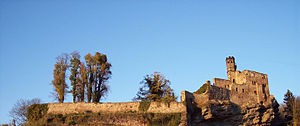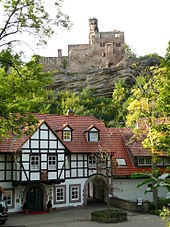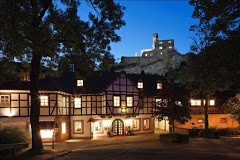Hardenberg Castle
N�rten-Hardenberg

The Hardenberg Castle is the ruin of a mountain castle near Nörten-Hardenberg.
The castle was built on a brow of a hill with steep rock walls. Today the remnants arouse the impression of a romantic castle ruin.
It is a twin-castle, named as front and back Hardenberg house. The one lineage lived in the older part of the castle facility the so-called back house. The other lineage lived in the northern part, the front house. To keep the peace and comply with duties both parties agreed upon a Burgfrieden (peace accord). Both castle areas were separated by a trench with a wooden bridge. The otherwise usual donjon doesn't feature in both castle parts even though the castle belonged to the church. Access is only possible via the north side over the moat. Due to disrepair and other dangers the castle ruin can only be visited within a guide tour as well as the viewing tower due to disrepair and other dangers.

The castle was founded by the archdiocese Mainz to monitor two trade routes. The fortification was first recorded as 'Vestes Haus' around 1101. In the year 1098 sought the archbishop Mainz Ruthard, shelter at the castle from the Salian Henry IV. In the middle of the 13th-century it were the gentlemen of Rosdorf Ministerials from Mainz. In the year 1287 the castle was besieged by the dukes Henry, Albert and William of Braunschweig. In the same year the castle was pawned against a high amount. The property didn't go to the earls of Hardenberg by coincident as they have been favoured by the Mainz archbishops often in the past. From them the Hardenberger purchased considerable estates among others also the village Nörten in 1287.
The masters of Hardenberg were now the owner of the castle. They still called themselves de Novalis. Bernhard de Novalis had the sons Günther and Hermann. The unrivalled position that the masters of Hardenberg possessed in the following years resulted from archbishop Henry III from Mainz who validated the pawning of castle and village Nörten in 1345. His successor Gerlach did the same in the year 1357. Over time the Hardenberger developed total freedom of action and lived alone in the castle. In 1375 Duke Albert of Braunschweig-Grubenhagen professes to protect the Hardenbergs for life, in return he gets fre access to the castle. In the meantime two lineages of the Hardenberg were established, which lead at times to disputes about the castle. The separation of the family estate, initiated by Dietrich of Hardenberg took place in 1409 and lead to the development of front and back house. The separation affected also the castle and in 1430 there is a dispute between Hildebrand of Hardenberg and his cousin Dietrich, graven to Hardinberghe twyschen syner borgh vnde myner, dar ek meine, dat der graven myn were. According to the saga a feud lead to the coat of arms of the family Hardenberg, the boar's head. It came to an attack at night during a siege of the castle by the masters of the castle Plesse. Apparantly a boar woke the castle inhabitants through loud oinking. The family of Hardenberg was splitt in two camps due to a contract of inheritance around 1403 already. That also had implications for the aristocratic estate, which became a twin-castle.
In a mediation by duke Heinrich von Braunschweig-Wolfenbüttel about one half of the house between Cord von Schwichelt, Hans von Steinberg and Dietrich von Hardenberg, as well as Hans von Hardenberg, one half of the house Hardenberg was awarded to Cord von Schwichelt but with the comment de overlicheyd unde de rechticheydt by the archbishop of Mainz.In 1607 the Mainz archbishop Johann Schweikhard announces to the Hardenbergern that he wants to redeem the Pfandthauß Hardenberg again. Only a legislative record from the year 1744 settled the dispute of both parties whereby the archbishopric of Mainz was not to dispute Hardenberg's private estate of the houses Hardenberg and Geismar. The comital tutor described how the front house gave in and collapse during a great thunderstorm in March 1698. The lineage 'front house' settled into nearby Göttingen and moved into the newly constructed palace Hardenberg at the foot of the hill in 1710. The lineage 'back house' left the castle in 1720.
In 1840 the castle was renovated and in addition a draw-bridge, an entrance gate and a new tower were built in neo Gothic. From 1962 onwards the castle was again renovated and excavations were done at the same time.

The castle Hardenberg was a popular destination for the students from Göttingen well into the 20th-century. On the 13. May 1848 the fraternity Hannovera was founded in an inn in Nörten-Hardenberg, which still exists in Göttingen. Accordingly numerous depictions of the castle ruin can be found on pictures.
The family von Hardenberg owns the castle ruin still today and operates a schnapps distillery in the village, which was founded by them in 1700. According to their own information the Hardenberg-Wilthen AG is Germany's second largest producer of spirituous beverages. Added were under the name Gräflicher Landsitz Hardenberg hotel business and gastronomy as well as organising numerous events like horse shows or a skating rinkevent in winter. Below the castle ruin on the former estate are today:
- Hotel
- Shop and sale of spirituous beverages from the schnapps distillery
- Palace park

 Deutsch
Deutsch Nederlands
Nederlands Dansk
Dansk Österreichisch
Österreichisch Po Polsku
Po Polsku Italiano
Italiano Francaise
Francaise Portugiesisch
Portugiesisch






